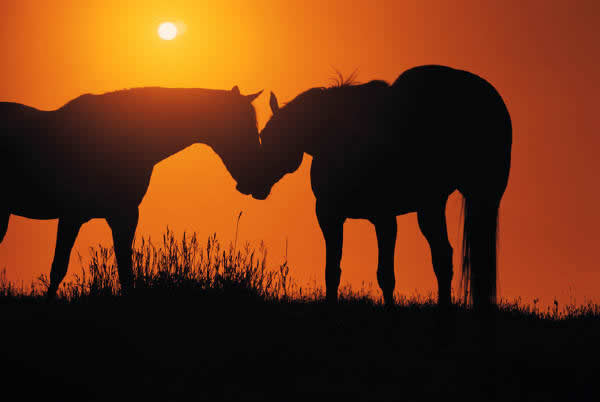
Home | Favorites|The Nature of Horses|Picture Gallery | Horse Training | Horse Whisperer | Wild Horses and Burros | Animal Abuse & Neglect | Spirit | War Horse | The Black Stallion | Flicka
The Nature of Horses
No other animal can match the contributions that horses have made to human civilization. What makes horses such good partners for people? Horses cannot learn the way people do; training horses involves working with their natural instincts, not trying to change them. But fortunately for us, most of the qualities that make horses helpful to humans were already present in wild horses. Their bodies are powerful, living machines that can work all day, powered only by grass. And their brains give them both the ability to understand subtle commands and the motivation to obey them.
This dramatic display shows a man struggling to control a rearing horse. But why can humans control horses at all, when horses are so much bigger and stronger than humans?
Horses are creatures of instinct. But certain instincts work in our favor. The way horses naturally evolved to eat, mate, form family groups and accept the authority of herd leaders makes them receptive to taking orders from humans as well.
Why do we ride horses, but not their close relatives, zebras? Male Grevy's zebras fight over territory, so they can't be kept in the same corral. Horses have no fixed territories, wandering constantly to graze, and fight less over turf. Zebras are also notorious for biting—in fact, zebras injure more zookeepers than tigers do.
One way to train horses is through brute force and intimidation. But some trainers instead appeal to a horse's natural instinct to follow a leader. For example, instead of beating a horse until it is afraid to disobey, a trainer might chase it away. Horses don't like being isolated from the herd, so the animal returns, seeking permission to end its banishment. From then on it accepts the human trainer as herd leader and follows instructions.
The need to avoid being alone is a powerful instinct for horses. In the wild, horses evolved in constant danger from predators such as wolves and mountain lions. They seek safety in numbers by living in herds. Young horses, or foals, always travel with their mothers in a family group guarded by a male horse, the lead stallion. Even young males, who must fight other stallions for the right to lead a family, often band together with other bachelor stallions.
Jumping can be frightening and dangerous for horses. So how do you get a young horse to jump over a fence for the first time? One way is to exploit the herd instinct: a young horse will follow an older horse over a fence to avoid being left behind.
Horses often pair off and form close partnerships with other members of their herd. But if they can't find a horse to partner with, they sometimes befriend another animal like a goat or housecat. This instinct also helps them bond with humans.
Horses spend a lot of time scratching each other's backs with their teeth. This grooming strengthens social bonds, reduces tension and increases trust. Similar grooming can help a human gain a horse's trust as well. Research shows that brushing the neck and back can lower a horse's heart rate by 11 to 14 percent-a clear sign of relaxation.
Horses have a strong instinct to form groups in which some horses lead and others follow. A typical family group consists of one male, several females and their offspring. The male stallion fights off predators and rival stallions, but the leader of day-to-day activities is usually a female. This lead mare decides where the group should go and punishes misbehavior. Every horse knows whether it is dominant or submissive to every other horse. If a new horse joins the group, it quickly sorts out where it stands.
Horses live in well-structured groups with clear followers and leaders. Without any human training, horses will line up behind a lead mare according to their rank in the herd, usually with a stallion guarding the rear.
By controlling the movement of horses with ropes and fences, humans can establish their dominance. Eventually, the horse will submit to being led around by a thin rope, or no rope at all, even though the horse is the stronger animal. One reason this works is that horses instinctively submit to a more dominant individual that controls their movements.
Dominance relationships are very important among horses. In fact, a faster horse will sometimes lose a race to a slower horse that expresses dominance through its body language. For people, the key to working with horses is to make it clear who is in charge. If you act unsure, the horse may ignore your commands.
**Information Resource: www.amnh.org/exhibitions/horse**
Email me at ryley.scott1307@gmail.com.